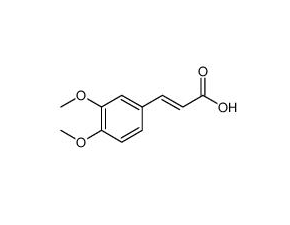
3,4-Dimethoxycinnamic acid
CAS No. 2316-26-9
3,4-Dimethoxycinnamic acid( O-Methylferulic acid )
Catalog No. M19332 CAS No. 2316-26-9
3, 4-Dimethoxycinnamic acid, previously identified in plasma after coffee consumption, was rapidly absorbed in the free form most likely by passive diffusion in the upper gastrointestinal tract.
Purity : >98% (HPLC)
 COA
COA
 Datasheet
Datasheet
 HNMR
HNMR
 HPLC
HPLC
 MSDS
MSDS
 Handing Instructions
Handing Instructions
| Size | Price / USD | Stock | Quantity |
| 100MG | 37 | In Stock |


|
| 200MG | Get Quote | In Stock |


|
| 500MG | Get Quote | In Stock |


|
| 1G | Get Quote | In Stock |


|
Biological Information
-
Product Name3,4-Dimethoxycinnamic acid
-
NoteResearch use only, not for human use.
-
Brief Description3, 4-Dimethoxycinnamic acid, previously identified in plasma after coffee consumption, was rapidly absorbed in the free form most likely by passive diffusion in the upper gastrointestinal tract.
-
Description3, 4-Dimethoxycinnamic acid, previously identified in plasma after coffee consumption, was rapidly absorbed in the free form most likely by passive diffusion in the upper gastrointestinal tract.
-
In Vitro3,4-Dimethoxycinnamic acid (Methyl ferulic acid; 25, 50 and 100 μM) attenuates the ethanol-induced apoptosis of ethanolexposed L-02 cells. 3,4-Dimethoxycinnamic acid (25, 50 and 100 μM) inhibits the expression levels of Nox4 and p22phox in L-02 cells. 3,4-Dimethoxycinnamic acid (25, 50 and 100 μM) treatment attenuates ethanol-induced MAPK phosphorylation in L-02 cells.3,4-Dimethoxycinnamic acid decreases the expression levels of superoxide dismutase, catalase and phospholipid hydroperoxide gluthione peroxidase, and downregulates the levels of Bax/Bcl-2 and the cleaved forms of caspase-3 in a dose- and time-dependent manner.
-
In Vivo——
-
SynonymsO-Methylferulic acid
-
PathwayOthers
-
TargetOther Targets
-
RecptorOthers
-
Research Area——
-
Indication——
Chemical Information
-
CAS Number2316-26-9
-
Formula Weight208.21
-
Molecular FormulaC11H12O4
-
Purity>98% (HPLC)
-
SolubilityIn Vitro:?DMSO : 50 mg/mL (240.14 mM)
-
SMILESCOC1=C(C=C(C=C1)/C=C/C(=O)O)OC
-
Chemical Name——
Shipping & Storage Information
-
Storage(-20℃)
-
ShippingWith Ice Pack
-
Stability≥ 2 years
Reference
1.Farrell TL,et al.Absorption of dimethoxycinnamic acid derivatives in vitro and pharmacokinetic profile in human plasma following coffee consumption. 2012 Sep;56(9):1413-23.
molnova catalog



related products
-
Velaresol
Velaresol (BW 12C79) is used for the study of tumors, sickle cell anemia and digestive disorders.
-
Peucenidin
Peucenidin is a natural product for research related to life sciences.
-
(Rac)-GSK 372475
(Rac)-GSK 372475 may be investigated for the treatment of Parkinson's syndrome, depression and obesity.



 Cart
Cart
 sales@molnova.com
sales@molnova.com


